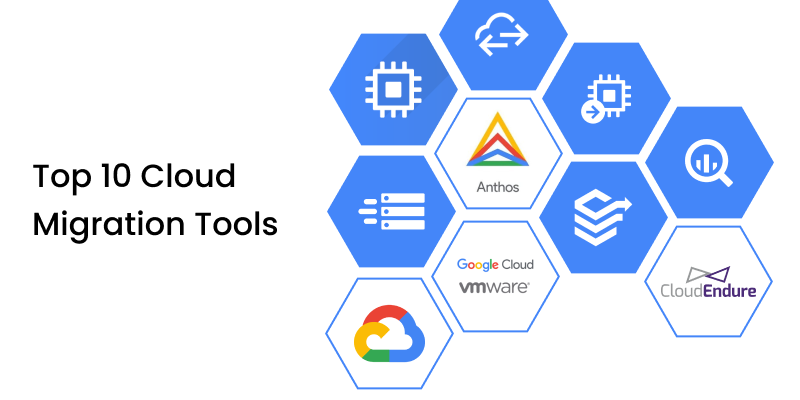The top 10 cloud migration tools of 2025 reflect the need for automation, real-time monitoring, and hybrid-cloud capabilities. Businesses adopting these tools will not only achieve smoother migrations but also position themselves to take full advantage of the cloud’s potential for growth and innovation.
As businesses embrace digital transformation, cloud migration has become a crucial strategy for improving flexibility, scalability, and cost-efficiency. Moving workloads, applications, and data from on-premises systems to the cloud requires careful planning and reliable tools that minimize downtime, reduce risk, and ensure data integrity. In 2025, cloud migration tools have evolved to integrate automation, artificial intelligence, and hybrid-cloud capabilities, making them more powerful and adaptable than ever before. Below are the top 10 cloud migration tools ranked from 10 to 1.
10. Carbonite Migrate
Carbonite Migrate offers an easy and secure way to replicate workloads to cloud environments with minimal downtime. Known for its simplicity, it supports real-time replication and ensures that critical systems remain available during migration.
This tool is particularly useful for small and medium-sized enterprises that require fast deployment without complex configurations. Its automation features help reduce manual intervention, and it is widely adopted for moving databases, applications, and servers to public or private clouds.
9. Velostrata (by Google Cloud)
Velostrata, acquired by Google Cloud, has established itself as a reliable migration solution for enterprises moving workloads to Google Cloud Platform. It offers real-time streaming of workloads, meaning businesses can run applications in the cloud without waiting for complete data transfer.
Its ability to separate compute from storage during migration reduces downtime and accelerates the process. Velostrata also provides robust testing capabilities, allowing organizations to validate workloads in the cloud before committing fully to migration.
8. Micro Focus PlateSpin Migration Factory
PlateSpin by Micro Focus is a large-scale migration tool designed for enterprises managing complex workloads. It supports multiple operating systems and cloud environments, making it a versatile choice for hybrid and multi-cloud strategies.
One of its strongest features is automation, enabling bulk migration of servers and applications. Businesses with thousands of workloads benefit from its centralized management, which reduces operational complexity and migration errors.
7. AppDynamics Cloud Migration Tool
AppDynamics, now part of Cisco, provides a monitoring-driven migration approach. While not strictly a migration engine, its tool helps organizations plan and execute migration by analyzing performance, dependencies, and risks before moving workloads.
This tool is particularly powerful for application-centric migrations where understanding dependencies is critical. With visibility into how applications behave before, during, and after migration, it reduces the likelihood of performance issues in the cloud.
6. CloudEndure (by AWS)
CloudEndure, acquired by Amazon Web Services, has become one of the most widely used migration tools for moving workloads into AWS. It provides continuous block-level replication and automated orchestration, ensuring near-zero downtime migrations.
Its disaster recovery capabilities make it more than just a migration tool, offering resilience even after workloads are running in the cloud. CloudEndure is particularly effective for large-scale migrations, giving businesses confidence in both speed and reliability.
5. Azure Migrate
Microsoft Azure Migrate is designed to simplify the process of moving workloads into the Azure ecosystem. It offers an all-in-one platform for discovery, assessment, and migration. With built-in dependency mapping, it allows organizations to understand how workloads interact before moving them.
Azure Migrate supports both on-premises and hybrid scenarios, making it suitable for enterprises of all sizes. Its integration with Microsoft’s ecosystem gives businesses added value when moving Windows workloads or enterprise applications like SQL Server.
4. VMware HCX
VMware HCX is a popular choice for organizations running workloads on VMware infrastructure. It simplifies hybrid cloud adoption by enabling live migrations, application mobility, and disaster recovery between VMware-based data centers and cloud environments.
One of its strongest capabilities is large-scale, live workload migration with minimal disruption. VMware HCX is particularly relevant for enterprises adopting hybrid or multi-cloud strategies where VMware continues to be the backbone of IT operations.
3. IBM Turbonomic and Cloud Pak for Applications
IBM has strengthened its cloud migration portfolio with Turbonomic and Cloud Pak for Applications. These tools provide AI-driven automation for analyzing workloads, optimizing resources, and accelerating migration.
Turbonomic focuses on ensuring applications perform optimally before, during, and after migration by dynamically allocating resources. Cloud Pak enables modernization of applications for cloud-native environments. Together, they help enterprises reduce risk and cost while ensuring seamless cloud transitions.
2. Google Migrate for Compute Engine
Google’s Migrate for Compute Engine is a fully integrated service that helps enterprises move workloads to Google Cloud with minimal friction. It provides live migration features, meaning workloads can continue running during the transfer.
The platform also includes assessment tools that analyze workloads to recommend optimal migration paths. Its strong integration with Google’s AI and data services makes it a natural choice for organizations aiming to leverage Google Cloud’s strengths in analytics and machine learning.
1. AWS Migration Hub
At the top of the list is AWS Migration Hub, Amazon’s comprehensive cloud migration service. It provides a single platform for planning, tracking, and executing migrations at scale. The hub supports various tools, including CloudEndure, Database Migration Service, and partner solutions, ensuring flexibility for different workloads.
Its central advantage is visibility—organizations can monitor the progress of multiple migration projects in real time. Combined with AWS’s global infrastructure, security, and automation capabilities, Migration Hub has become the most trusted tool for large-scale cloud migrations in 2025.
Conclusion
Cloud migration is no longer just a technology initiative but a business strategy that enables agility, innovation, and resilience. From tools like Carbonite Migrate, designed for small enterprises, to AWS Migration Hub, built for global-scale transformations, the options available today offer solutions for every scenario.
